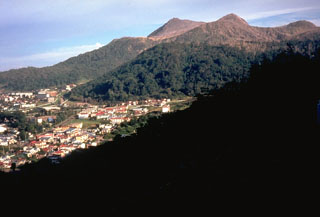Report on Toya (Japan) — January 1978
Scientific Event Alert Network Bulletin, vol. 3, no. 1 (January 1978)
Managing Editor: David Squires.
Toya (Japan) Decreasing ground movement, but light tephra 13 January
Please cite this report as:
Global Volcanism Program, 1978. Report on Toya (Japan) (Squires, D., ed.). Scientific Event Alert Network Bulletin, 3:1. Smithsonian Institution. https://doi.org/10.5479/si.GVP.SEAN197801-285030
Toya
Japan
42.544°N, 140.839°E; summit elev. 733 m
All times are local (unless otherwise noted)
Weak white and grayish-white steaming from vents and fissures near the summits of O-Usu and Ko-Usu continued during December, with a maximum cloud height of about 300 m. On 13 January, white steam clouds rose about 500 m from [a new vent (named B)] at 0740 and at 1125. A thin layer of ash was seen on top of snow at Date City (about 10 km SE of Usu) and Sobetsu (about 5 km NW of Usu).
Cryptodome uplift . . . declined slightly (to about 35 cm/day in December, from about 40 cm/day the preceding month). Subsidence at Ko-Usu, about 30 cm/day in November, decreased to about 15 cm/day in December. Daily local seismicity also decreased slightly in December.
Geological Summary. Usuzan, one of Hokkaido's most well-known volcanoes, is a small stratovolcano located astride the southern topographic rim of the 110,000-year-old Toya caldera. The center of the 10-km-wide, lake-filled caldera contains Nakajima, a group of forested Pleistocene andesitic lava domes. The summit of the basaltic-to-andesitic edifice of Usu is cut by a somma formed about 20-30,000 years ago when collapse of the volcano produced a debris avalanche that reached the sea. Dacitic domes erupted along two NW-SE-trending lines fill and flank the summit caldera. Three of these domes, O-Usu, Ko-Usu and Showashinzan, along with seven crypto-domes, were erupted during historical time. The 1663 eruption of Usu was one of the largest in Hokkaido during historical time. The war-time growth of Showashinzan from 1943-45 was painstakingly documented by the local postmaster, who created the first detailed record of growth of a lava dome.
Information Contacts: JMA, Tokyo; T. Tiba, National Science Museum, Tokyo; Y. Katsui, Hokkaido Univ.

